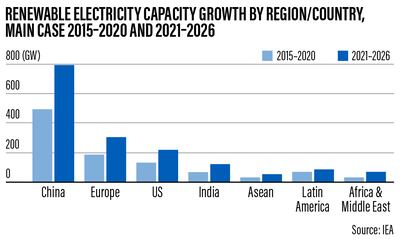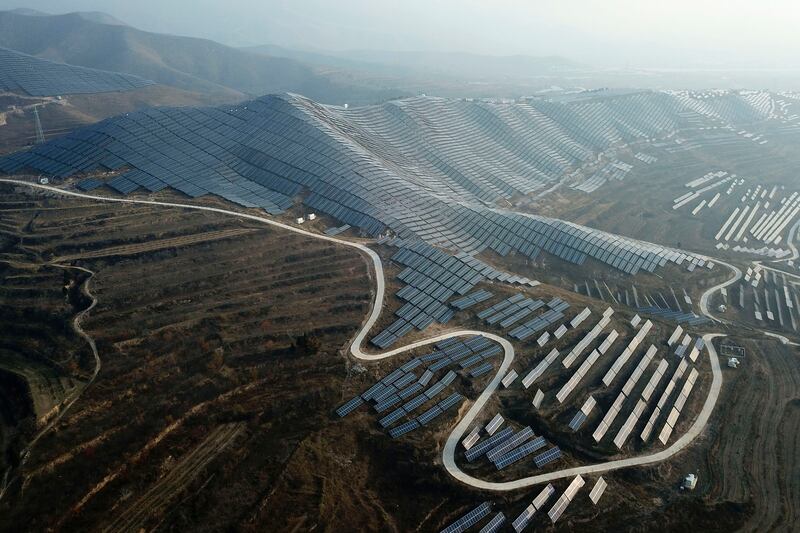New renewable power capacity is projected to rise to 290 gigawatts this year, setting a “fresh all-time record for new installations”, the International Energy Agency has said.
The global renewable electricity capacity is forecast to rise to more than 4,800 gigawatts by 2026, up 60 per cent from 2020 levels, the Paris-based organisation said in its annual Renewables Market Report released on Wednesday.
The amount of renewable capacity from 2021 to 2026 is expected to be 50 per cent higher than the levels between 2015 and 2020, driven by stronger government policies and more ambitious clean energy goals announced before and during the Cop26 climate change conference, the report said.
“This year’s record renewable electricity additions of 290 gigawatts are yet another sign that a new global energy economy is emerging,” said Fatih Birol, IEA’s executive director.
China will drive the renewable capacity growth over the coming years – accounting for 43 per cent of global renewable capacity growth – with Europe, the US and India following close behind, the IEA said. These four markets together will account for 80 per cent of global renewable capacity expansion.
Clean energy generation has picked up pace, boosted by the collective will to build back better after the pandemic. Many countries, including major oil-dependent nations, have pledged to reach net-zero emissions by the middle of the century as they strive to keep the lid on emissions and mitigate climate change.
The UAE became the first country in the Middle East and North Africa region to adopt the pledge to offset all of its domestic carbon emissions by 2050, followed by Saudi Arabia and Bahrain.
In line with its net-zero initiatives, the UAE plans to plough $160 billion over the next three decades to hasten renewable energy development. The Emirates will also host the 28th Conference of the Parties in 2023 in line with the global efforts to transition away from fossil fuels.
Renewables will account for almost 95 per cent of the increase in global power capacity in the next five years, with solar photovoltaic (PV) alone providing more than half, the IEA said.

Solar PV, a method through which raw energy from the sun is absorbed to create usable energy, leads the growth in renewable electricity, with its capacity additions forecast to increase by 17 per cent this year, to a record of almost 160 gigawatts, as per the IEA's estimates.
“We have revised up our forecast from a year earlier, as stronger policy support and ambitious climate targets announced for Cop26 outweigh the current record commodity prices that have increased the costs of building new wind and solar PV installations,” the energy agency said.
The IEA expects this record growth for renewables to take place despite challenges, including today’s high commodity and transport prices.
“The high commodity and energy prices we are seeing today pose new challenges for the renewable industry, but elevated fossil fuel prices also make renewables even more competitive,” Mr Birol said.
Rising commodity, energy and shipping prices have increased the cost of producing and transporting solar PV modules, wind turbines and biofuels worldwide.
Since the beginning of 2020, prices for PV-grade polysilicon more than quadrupled, steel has increased by 50 per cent, aluminium by 80 per cent, copper by 60 per cent and freight fees have risen six-fold, the IEA said.
Many “restrictive trade measures have brought additional price increases to solar PV modules and wind turbines in key markets such as the US, India and the EU”.
However, should commodity prices remain high through the end of next year, the cost of wind investments would go back up to levels last seen in 2015 and three years of cost reductions for solar PV would be erased, the IEA said.
“Despite rising prices limiting growth, global biofuel demand in 2021 is forecast to surpass 2019 levels, rebounding from last year’s huge decline caused by the pandemic,” the report said.
Demand for biofuels is set to grow strongly to 2026, as per IEA estimates, with Asia accounting for almost 30 per cent of new production. India is expected to rise to become the third largest market for ethanol worldwide, behind the US and Brazil, the energy body said.
However, renewables face a number of policy uncertainties and implementation challenges. To get renewables on track with net zero by 2050, governments not only need to address these problems but also increase ambition for all renewable energy uses, said the IEA.
Governments can further accelerate the growth of renewables by addressing “key barriers, such as permitting and grid integration challenges, social acceptance issues, inconsistent policy approaches and insufficient remuneration”.
High financing costs in the developing world are also a major obstacle, it added.







